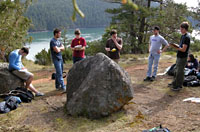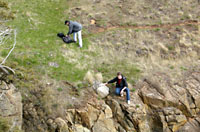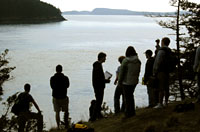Class exposure dating project
In class we've discussed the theory behind radiometric dating methods, but lectures can't convey the nitty gritty technicalities of geochronological field and lab work. It‘s easy to write formulas describing how isotopic ratios and concentrations evolve with time. But how do we select samples in the field to begin with? How do we separate the minerals we need? What does it take to dissolve them? And what's inside that mass spectrometer anyway?*
To provide some hands-on experience of these things, the class has twice collected and dated boulders from a glacio-marine deposit on the shores of Fidalgo Island, in Puget Sound. The dating method is based on the build-up of a cosmic-ray-produced nuclide – Be-10. Accumulation of this nuclide allows us to calculate cosmic ray exposure ages of the boulders. From our geological examination of the site, and what’s already known about the deglaciation history of Puget Sound, we think these rocks were deposited below sea level during retreat of the Puget Lobe of the Cordilleran Ice Sheet. Flow-direction indicators show that westwards-flowing ice remained over Fidalgo and northern Whidbey Islands after the main Puget Lobe retreated to the north. Our sample site was exposed by retreat of this ice, known to have occurred some time after 15,500 years ago. Pockets of remnant till can be found around the site, indicating that the boulders were originally part of a till deposit draping the (leeward) western slope of Fidalgo Island. Most likely this deposit formed below sea level, but rose isostatically after retreat of the Puget Lobe, exposing the deposit to erosion which eventually uncovered the boulders. Thus exposure ages for these rocks set minimum limits on the age of deposition and ice retreat - we expect exposure ages younger than 15,500 years, perhaps with the youngest ages at sea level and older ages at higher elevation. Remember however, that these rocks weren't dated before we did this work - we won't know the real answer until we've done the measurements. This is real science.
On Friday 11 April we successfully collected three samples for exposure dating from Fidalgo Island. The flowchart below shows the steps required to measure their exposure ages.




